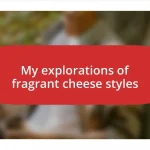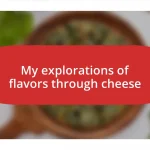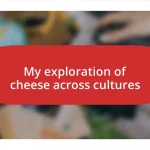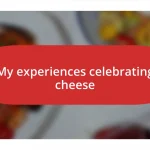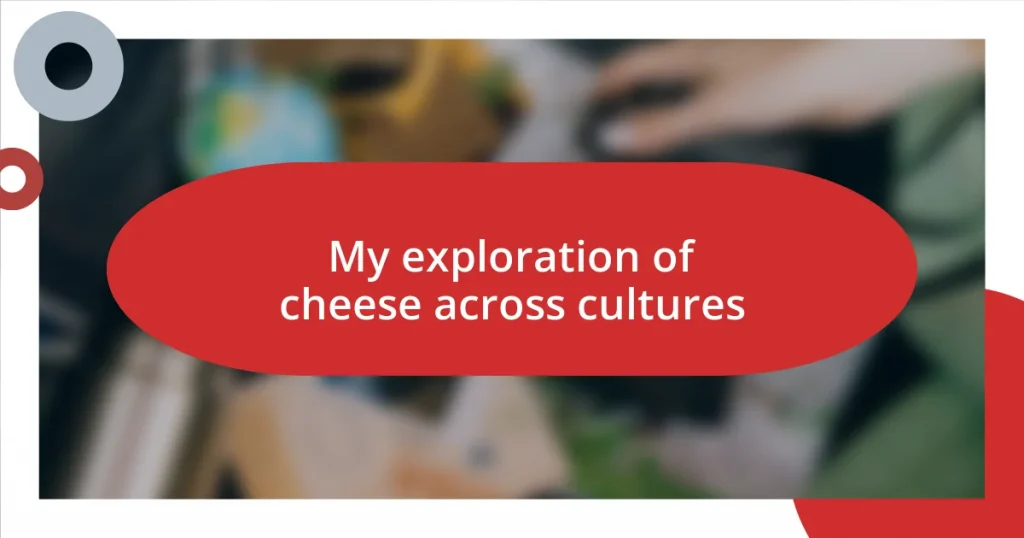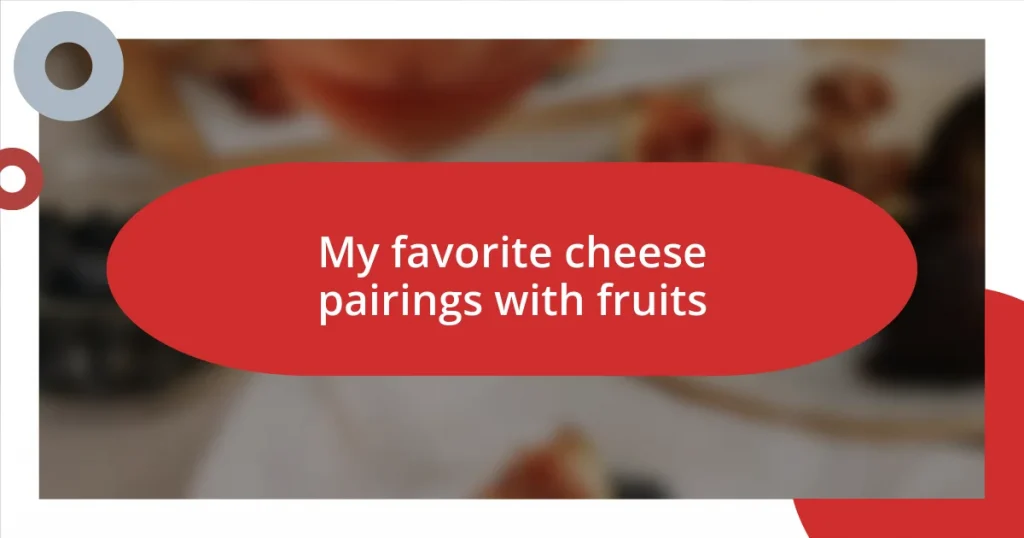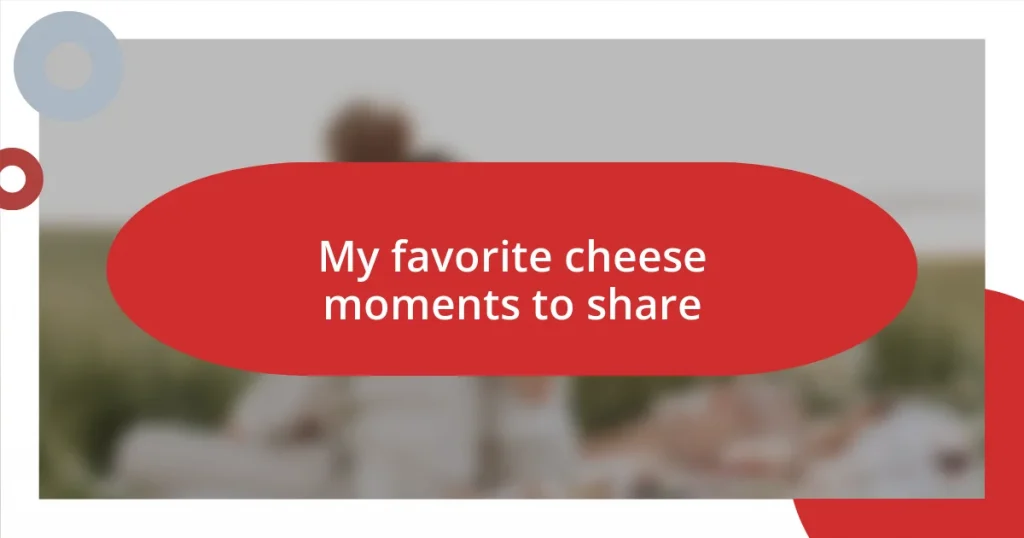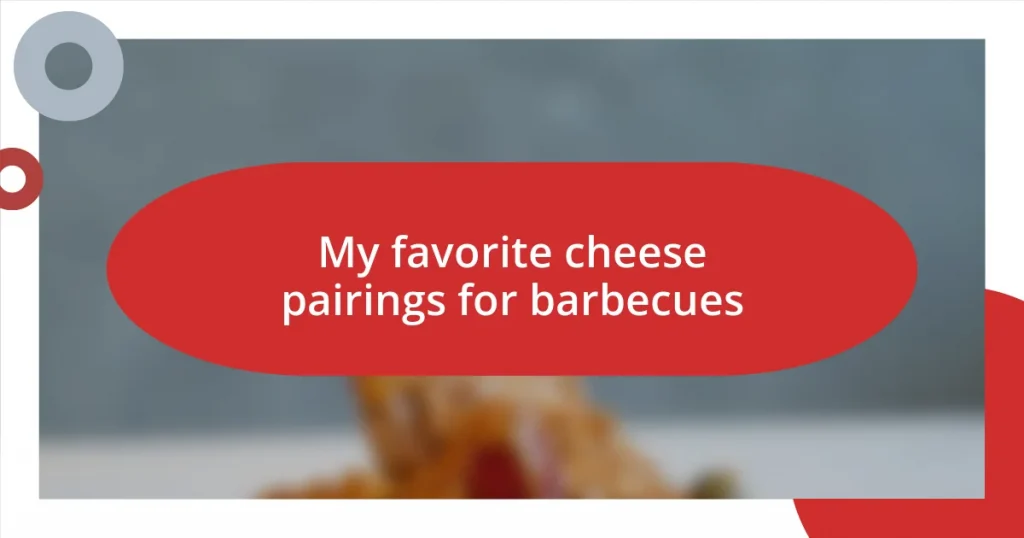Key takeaways:
- Cheese serves as a cultural icon, reflecting the heritage and traditions of various regions, with unique flavors and production techniques worldwide.
- Global cheese production showcases diverse varieties, with artisanal cheese practices in America emphasizing quality, local ingredients, and community engagement.
- Pairing cheese with local foods enhances cultural experiences, as seen in cheese festivals that celebrate regional flavors and bring communities together through shared culinary enjoyment.
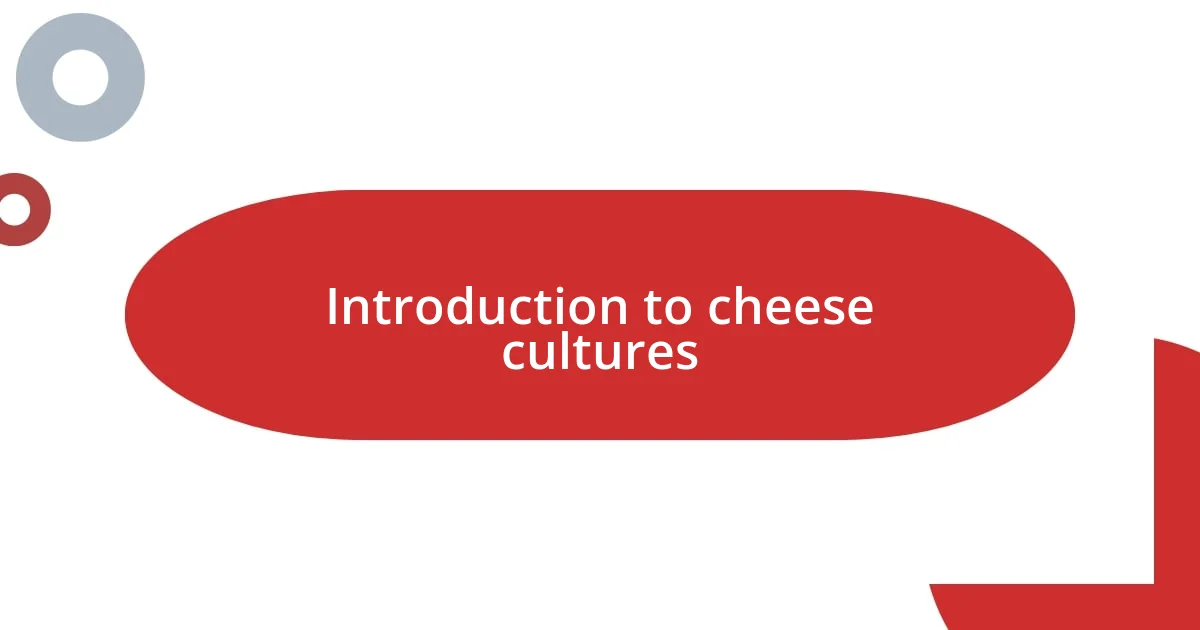
Introduction to cheese cultures
Cheese is more than just a food; it’s a cultural icon that tells stories of heritage, tradition, and community. I still remember my first trip to France, where I savored different cheese varieties, each reflecting the regional landscapes and history. Isn’t it fascinating how a simple wheel of cheese can encapsulate the essence of a place?
As I delve deeper into the world of cheese cultures, I find it captivating how various countries have distinctive kinds of cheese that align with their culinary practices and local ingredients. For instance, the robust flavors of aged Italian cheeses evoke the rustic charm of Italian kitchens, while the delicate, creamy textures of Brie’s origins in Normandy speak to the lush pastures of French farms. Have you ever considered how these nuances shape our tasting experiences?
Exploring cheese across cultures reveals not just diverse flavors, but also the rituals surrounding its creation and enjoyment. In many cultures, cheese-making is a family affair, passed down through generations. I often think about the families sitting around the table, sharing stories as they enjoy their hand-crafted cheese. What experiences inform your own appreciation of cheese?
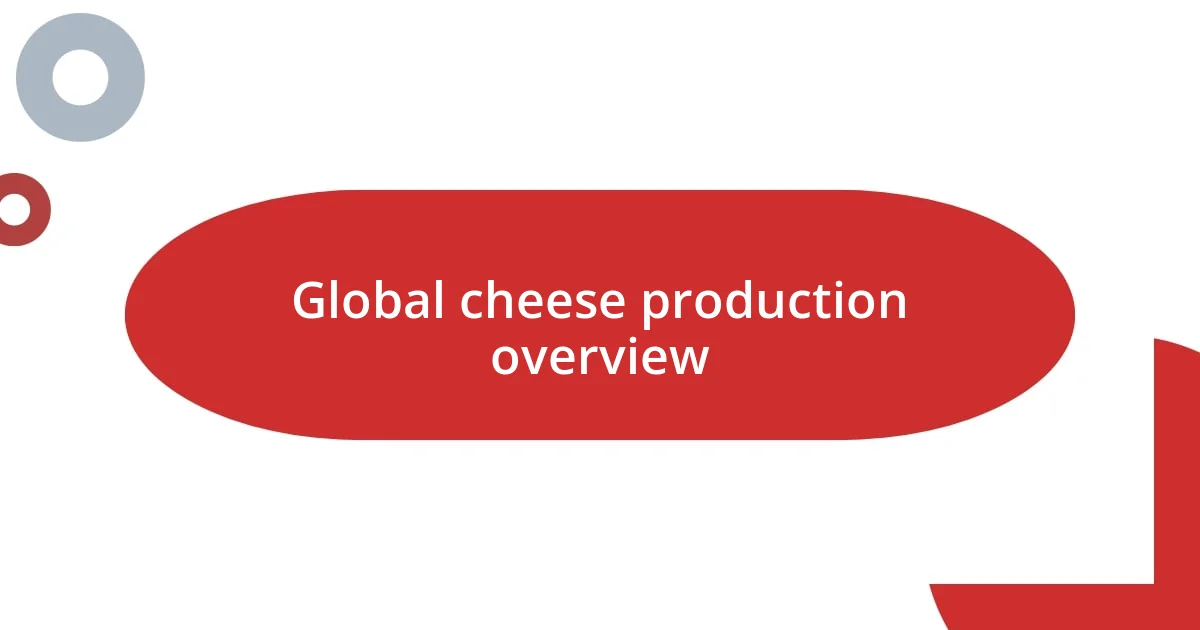
Global cheese production overview
Cheese production is a global phenomenon, with every corner of the Earth contributing its unique flavors and techniques. From the towering Alps of Switzerland to the sun-soaked plains of Argentina, the diversity in cheese-making practices is astounding. I remember visiting a small dairy farm in the Italian countryside, where the cheesemaker lovingly explained the aging process of Parmigiano-Reggiano—the care and attention were palpable, and I think that respect for tradition is evident in the production of cheese across different cultures.
Here are some interesting global cheese production facts that highlight its vastness and diversity:
- An estimated 21 million tons of cheese were produced globally in 2021.
- The top cheese-producing countries include the United States, Germany, and France, each specializing in distinct varieties.
- Italian cheese types like Mozzarella and Gorgonzola are famous worldwide and hold a special place in many cuisines.
- In India, traditional cheese known as Paneer is not just a staple but also a part of various culinary rituals.
- The average person in France consumes around 25 kilograms of cheese per year, showcasing the cultural importance of cheesy delights.
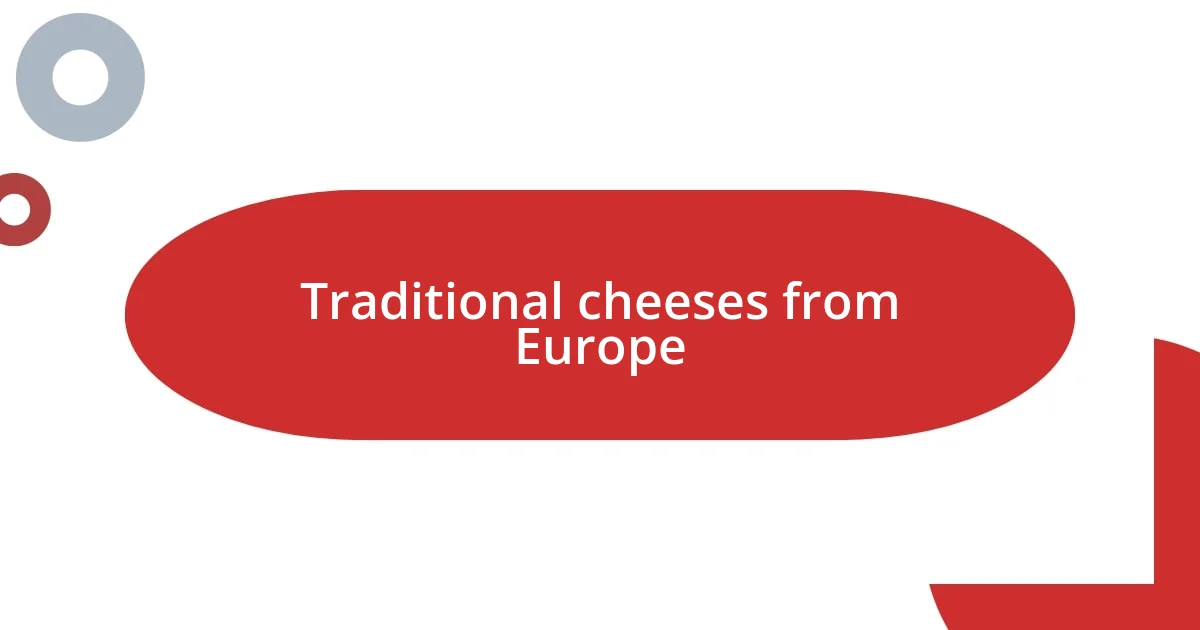
Traditional cheeses from Europe
The heart of Europe boasts a myriad of traditional cheeses, each with its own unique backstory and taste profile. Take Gouda from the Netherlands, for example; its sweet, nutty flavor evokes memories of cozy evenings spent in cheese shops, sampling rounds and learning about its production. I once enjoyed a cheese pairing event where various aged goudas were showcased, their complex layers reminding me of an intricate musical composition.
Then there’s Roquefort from France, a blue cheese with a rich history that goes back centuries. The sharp tang of Roquefort is balanced with a creamy texture, and I remember the first time I paired it with a robust glass of red wine—it felt like a revelation! The crumbly blue veins held an unmistakable crunch, and I could taste the region’s rugged landscape in each bite.
Across the Mediterranean, Italy shines with its Parmigiano-Reggiano, often referred to as the “King of Cheeses.” The meticulous aging process sets it apart, leading to that distinctive crystalline texture and savory umami flavor. I recall a visit to a Parmesan factory in Emilia-Romagna; the cheesemaker, with years of experience etched on his face, shared stories about tradition and craftsmanship that truly brought the cheese to life. It’s these stories that remind me that cheese offers a window into local culture and heritage.
| Cheese | Origin |
|---|---|
| Gouda | The Netherlands |
| Roquefort | France |
| Parmigiano-Reggiano | Italy |
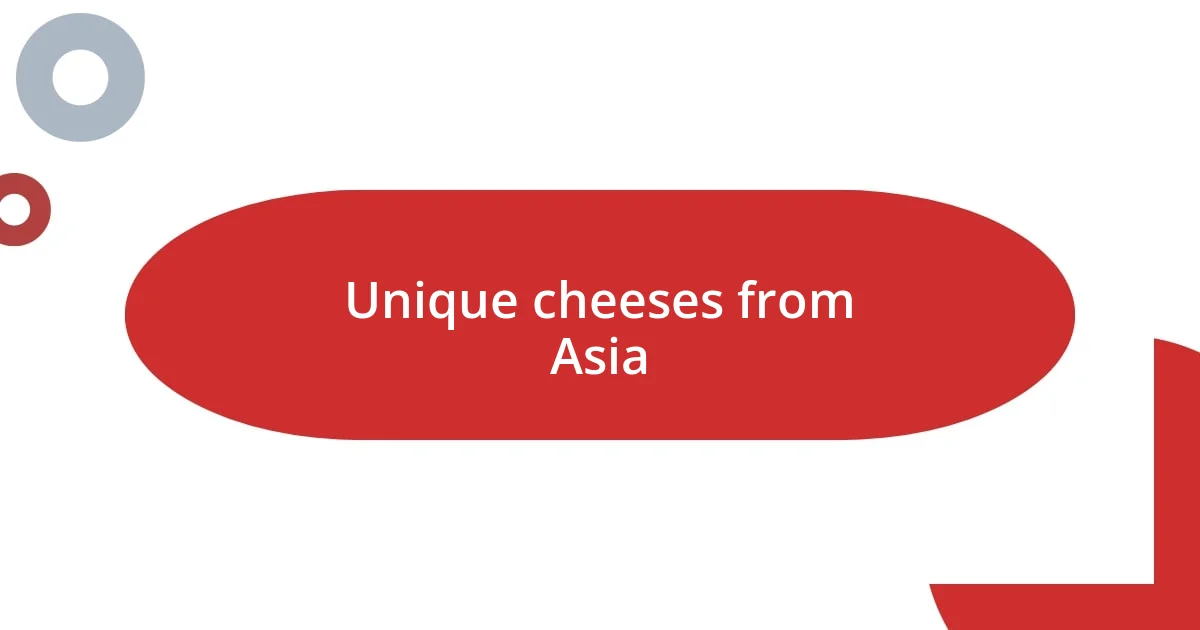
Unique cheeses from Asia
When we venture into the world of Asian cheeses, a surprising delight awaits. Take Churu from Mongolia, for instance—a unique dried cheese made from fermented camel milk. I had the chance to sample it during a trip to the steppes, and its crumbly texture paired with a hint of tanginess was both refreshing and oddly comforting, reminding me of how different ingredients reflect their native landscapes.
In India, I was captivated by the versatility of Paneer—this fresh cheese is an essential ingredient in so many beloved dishes. I remember cooking a delightful Paneer Tikka Masala with a local family; as we chopped and marinated, the excitement was palpable. It’s fascinating to think that Paneer, made simply by curdling milk with lemon juice, embodies not just flavor but also the warmth of cultural gatherings.
Another gem worth mentioning is Queso Blanco, popular in several Southeast Asian countries. My first encounter with it was during a market visit in Indonesia, where street vendors offered it fresh, drizzled with sweet chili sauce. The mild, creamy cheese was a perfect foil for the spicy heat, and I still recall that moment of culinary harmony—how food can bridge diverse flavors and bring people together in laughter and shared enjoyment.
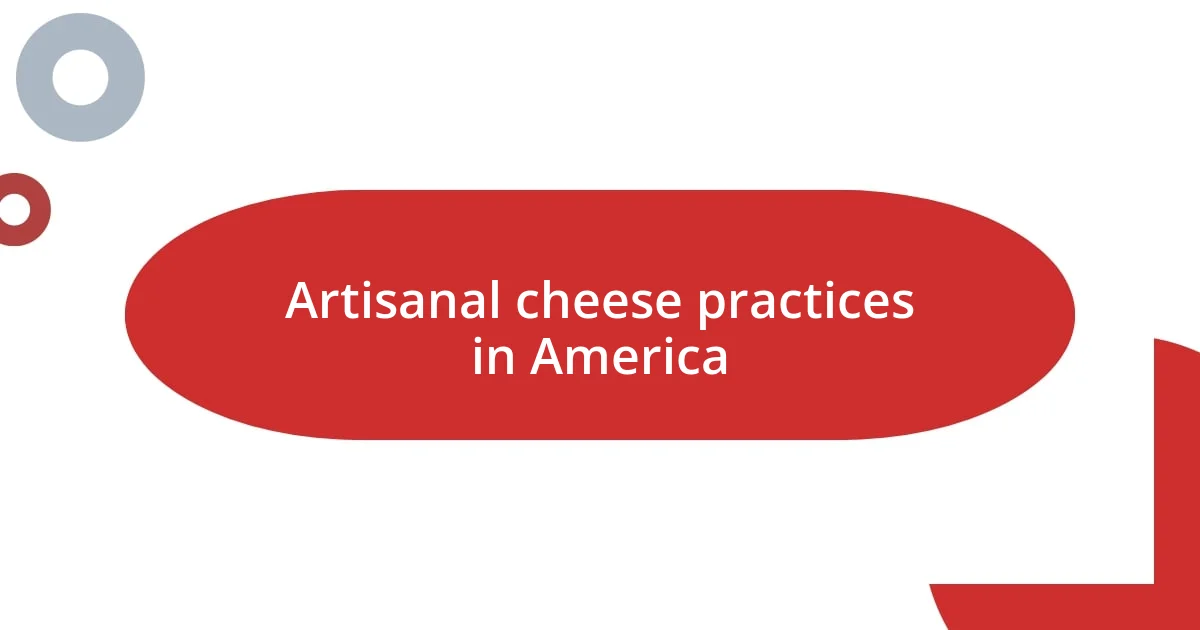
Artisanal cheese practices in America
Artisanal cheese practices in America have flourished in recent years, driven by a resurgence of traditional methods and a passion for quality over mass production. I remember my first visit to a small, family-run creamery in Wisconsin, where the cheesemaker shared his daily routine of handcrafting cheese curds, a labor of love that produced a rich, tangy cheddar. The way he poured his heart into each batch made me appreciate the connection between the maker and the product deeply.
What really strikes me is the incredible diversity in artisanal cheese across the country. For instance, in California’s Sonoma County, I had the privilege of tasting goat cheese infused with local herbs at a charming farmstead. Every bite was a burst of flavor, and I found myself pondering—how does this local terroir influence what I’m savoring? It’s delicious reminders like these that make me realize there’s a story behind each cheese, tied to the land, the climate, and the skilled hands that created it.
Moreover, the community around artisanal cheese is just as captivating as the cheese itself. At a farmers’ market in Vermont, I stumbled upon a vibrant cheese stall brimming with intriguing varieties. As I chatted with the vendor, who was eager to share his experiences and pairing suggestions, it felt like I was part of a larger conversation about sustainability and heritage. This sense of camaraderie among cheesemakers and cheese lovers alike adds a personal touch to each cheese tasting, making the experience feel more like a celebration than just a meal.
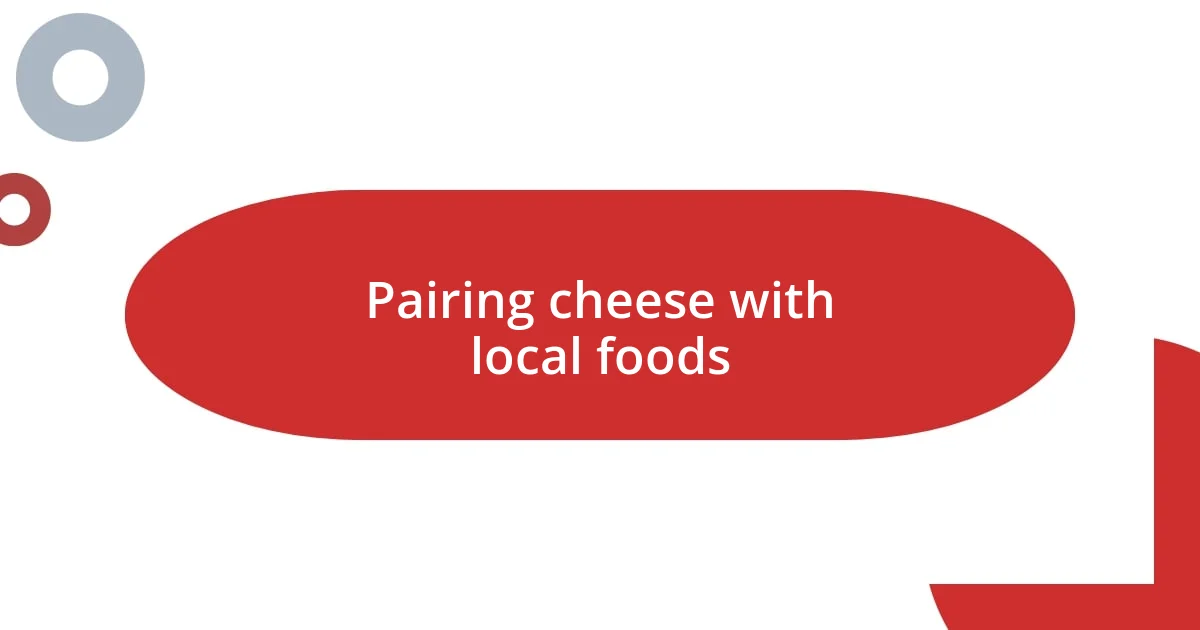
Pairing cheese with local foods
Imagine biting into a slice of creamy Brie while savoring a crusty baguette on the bustling streets of Paris. During my journey in France, I discovered how the local tradition of pairing Brie with freshly baked bread adds a layer of indulgence that’s truly unique. Each bite was not only a delight to the palate but also a reminder of the joy that comes from simple, local ingredients dancing together.
In Italy, I encountered a delightful combination of Gorgonzola and honey drizzled over fresh figs. I remember sitting at a quaint café, the sun casting a golden hue over the vibrant plates before me. The rich, blue-veined cheese contrasted beautifully with the syrupy sweetness of the honey, creating a tapestry of flavor that was as memorable as the picturesque setting. Doesn’t it make you wonder how certain flavors can evoke such deep emotional connections?
And let’s not forget the charm of pairing cheese with locally produced wines. I had the pleasure of attending a small wine and cheese festival in a rustic vineyard, where we sampled aged Gouda alongside a robust Pinot Noir. The way the nutty, caramel notes of the cheese complemented the wine made me realize how local producers harness the essence of their environment. Isn’t it fascinating how cheese can act as a conduit for tasting the very landscape it comes from? Each pairing tells a story, and it’s those narratives that make the experience truly rich and engaging.
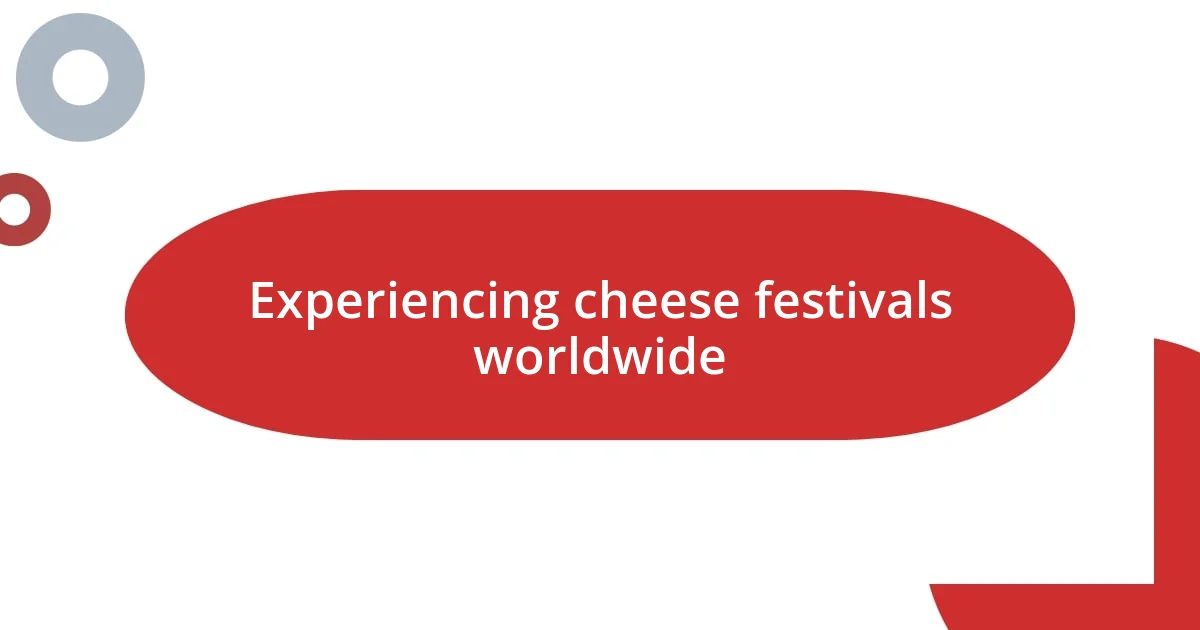
Experiencing cheese festivals worldwide
There’s something magical about attending cheese festivals around the world. I remember stepping into the bustling scene at the Fromage Festival in France, surrounded by booths showcasing an array of cheeses, from creamy Camembert to tangy Roquefort. The sheer excitement in the air was palpable as I sampled countless varieties and chatted with passionate cheesemakers who were eager to share their stories. Have you ever felt that rush of joy when you discover a cheese you adore among so many?
Traveling to the Cheesemonger Invitational in New York was another unforgettable experience. This event brought together artisans from near and far, showcasing not just their cheeses but their deep-rooted philosophies about cheesemaking. As I tasted a delightfully aged pecorino, I engaged in conversation with its creator, who explained how aging processes impact flavor. Listening to their personal journey felt like a warm invitation into their world—one shaped by their commitment to craftsmanship.
In Italy, the Forma e Cibo Festival was a festival of the senses. I remember getting lost in the wafting aromas of truffle-infused cheeses, while musicians played lively folk tunes nearby. The joy of sampling pecorino with its rich, savory notes, paired with a glass of vibrant Chianti, felt like a celebration of life itself. Doesn’t it make you think about how food can bring people together, creating a community around shared experiences and flavors?



